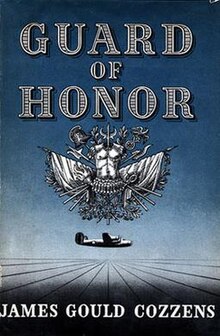 Hardback first edition | |
| Author | James Gould Cozzens |
|---|---|
| Language | English |
| Publisher | Harcourt, Brace and Company |
Publication date | 1948 |
| Publication place | United States |
| Media type | Print (hardback & paperback) |
| Preceded by | The Just and the Unjust |
| Followed by | By Love Possessed |
Guard of Honor is a Pulitzer Prize-winning novel by James Gould Cozzens published during 1948. The novel is set during World War II, with most of the action occurring on or near a fictional Army Air Forces base in central Florida. The action occurs during a period of approximately 48 hours. The novel is chapterless in form, using three progressively longer parts entitled "Thursday", "Friday" and "Saturday". From dates on various memoranda quoted, the story takes place on September 2, 3, and 4, 1943.
Before entering the USAAF during 1943, Cozzens had already published 10 novels; his duties included writing speeches and articles for Henry H. Arnold, commanding general of the USAAF. Cozzens worked in the USAAF Office of Information Services, a liaison and "information clearinghouse" between the military and the civilian press (like his Guard of Honor character Nathaniel Hicks, Cozzens' first duty was revising field manuals). One of the functions of his office was in controlling news, and it became Cozzens’ job to defuse situations potentially embarrassing to Arnold.
One such incident occurred during April 1945: African-American officers protested the segregation of officer club facilities in what became known as the Freeman Field Mutiny. Cozzens included a fictional but similar incident in Guard of Honor, not as a dramatic recreation of the incident but as backdrop for his analysis of the relationship between fate and the character and personality of leaders. Although several African-American characters appear in Guard of Honor, none are point-of-view figures.
Guard was one of Cozzens' "professional novels", in which he drew detailed portraits of individuals, centering on their professional lives and the details of their work. He expertly recreates the feel of the stateside Army Air Forces, accurately recalls historical facts pertinent to the story line without becoming academic, and references airplanes and technical aspects without excessive explanation and without bogging down the action. All characters in the novel, except Nathaniel Hicks, are named throughout using their rank or title and last name.